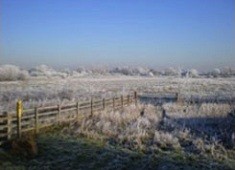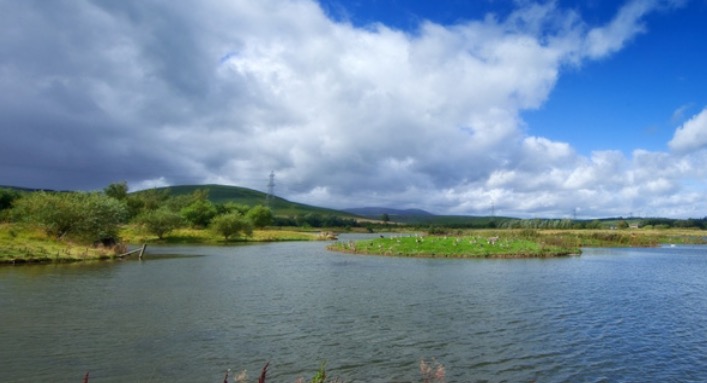Cossington Meadows
Working with the Leicestershire and Rutland Wildlife Trust, CEMEX UK has turned a disused gravel pit into an 86 hectare nature reserve. Cossington Meadows acts as a natural floodplain and attracts a rich diversity of birds and other wildlife.

Frost over Cossington Meadows

A stoat by Tern Pool (Photo credit: T Matthews)
CEMEX relies on raw materials such as limestone, gravel and clay to make its cement and concrete products. These are essential for building the roads, schools and homes that society needs, but quarrying the materials has the potential to degrade habitats and damage species unless the land is carefully managed. We are determined to have a positive impact on nature by promoting a diverse range of habitats and species while quarries are active, and by rehabilitating disused sites. By restoring former quarry sites we also provide communities with new nature reserves and education and leisure facilities.
Cossington Meadows, in Leicestershire, is one of several former quarry sites that we are rehabilitating. After quarrying the site in the 1980s and 1990s, we have now created a wetland habitat that supports nature, recreation, environmental education and flood plain management. The 86-hectare nature reserve is managed by the Leicestershire and Rutland Wildlife Trust, and is the largest of their six nature reserves in the Soar valley.
Cossington Meadows has a series of pools of water of different depths and it lies alongside the River Soar, which can flood in winter. As the floods recede, shallow pools of water form in the reserve, which rainwater adds to. When these pools dry up during summer they expose areas of mud that provide excellent feeding ground for birds. Deeper pools provide habitat for different species and the flood waters deposit wetland plant seeds all over the reserve, encouraging vegetation to grow.
CEMEX UK worked closely with the Leicestershire and Rutland Wildlife Trust to restore the site. The Trust has created more shallow pools, dug new ponds and introduced rafts for common terns to nest on.
Grazing cattle and ponies helps to control the growth of willow scrub and coarse vegetation, and tall hedges provide food and cover for insects and birds. New, marked footpaths guide visitors around the reserve so they can view the wildlife without disturbing the environment, creating both a recreational and educational resource.
The regeneration of Cossington Meadows provides a range of habitats for wildlife. The deeper pools attract wildfowl including gadwall, tufted duck and great crested grebe to breed on the reserve. In winter, rare ducks such as velvet scoter and garganey are also present.
The muddy edges of the shallower water provide a habitat for wading birds such as oystercatcher and green sandpiper. Grey kestrel and kingfisher also live on the reserve and, as the swamp vegetation spreads, birds such as reed bunting and reed warbler can be seen. The reserve also provides a breeding ground for grass snakes, toads, frogs and dragonflies.
Cossington Meadows is a popular bird-watching site where local people can learn about wildlife and see species in their habitat. The site also acts as a natural flood plain, protecting the surrounding landscape from flooding.
It is important for active community liaison is started when the quarry is in operation. CEMEX UK took over the site towards the end of its working life and it came with a significant amount of restoration that had to be completed. Despite this, good restoration has been completed by, for example, utilising soils from newly formed scrapes to grade banks and create mudflats for the benefit of waders and over- wintering waterfowl.
The site is located next to the River Soar and is regularly flooded, the restoration of the site gave the Environment Agency through CEMEX's operations the opportunity to create channels to divert floodwater along the valley floor, for the protection of the local community.
With help from experts at the Royal Society for the Protection of Birds (RSPB), we have developed an ambitious ten-year biodiversity strategy. This sets challenging targets, including our goal to create and maintain, by 2020, 1,000 hectares of habitats identified by the UK Government as conservation priorities.
For more information please contact us.
